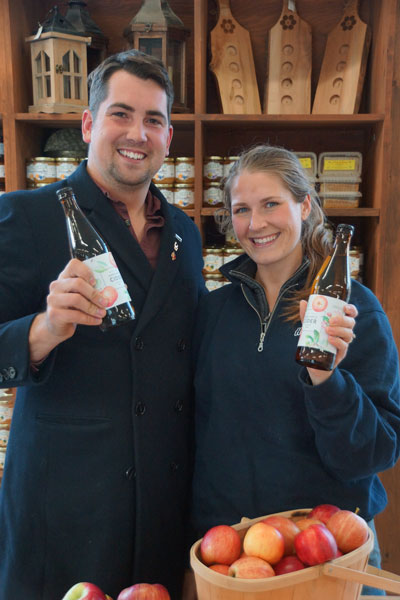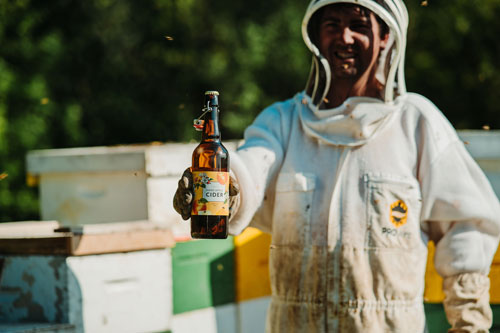5/1/2022
Passion Produces Profits
Bill McCurry
 (Editor’s note: This column looks a little different this month, as Bill highlights a unique business in an expanded space.)
(Editor’s note: This column looks a little different this month, as Bill highlights a unique business in an expanded space.)
At one Christmas dinner, the Heeman family sampled over 20 different ciders. It was a work project. Everyone was required to sample, review and rate each cider. Tom Heeman, third generation at Heeman’s Garden Centre and Strawberry Farm in Thorndale, Ontario, Canada, and his bride Susan Judd, were finalizing their plans to add hard cider to the company’s product mix.
Part of the cider investigation was personal. The couple’s passion for ciders has been reinforced by Susan’s gluten intolerance, which dramatically restricts her food choices. Cider became a personal alternative for her. They asked the family, “Will customers buy hard ciders?”
Getting Serious
Although Tom and Susan love cider, it had to make business sense. A graduate of AALP (Advanced Agricultural Leadership Program–Ontario), Tom has opportunities to visit and network with various businesses throughout North America. The couple’s interest in cider-making turned business connections into social connections and vice-versa.
Pictured: Tom and Susan Heeman with their cider.
By using existing facilities during the slow season, the cost and risk of entry in a cidery were lowered. Tom focused on Heeman’s established investments, like their powerhouse social media, reputation, personnel, customer support, financial strength and physical plant.
“We visited dozens of cideries to understand the production process and determine what we liked and didn’t like,” Tom says. “This wasn’t a hobby, so we budgeted $25,000. At that price, you need an exit strategy if things go wrong. Worst case, we identified places where we could off-load equipment and supplies to limit our losses.”
Things didn’t go as expected. The first cider production run was 1,000 liters, or 2,000 bottles—enough for several weeks based on estimated sales. The retail store opened at 8:00 a.m. with a line waiting in front. Heeman’s social media and electronic marketing succeeded. The cider went on sale with a six-bottle limit per shopper. The entire inventory sold out that day. “It was unbelievable!” was Tom’s understatement. Soon they’ll brew cider and mead in a newly constructed 7,000-square foot building.
Popular in Roman times, mead wasn’t well known in modern-day Canada. “We had to do some convincing to get customers to try it,” Susan remembers. Today, there’s a small, but growing, base of mead aficionados who eagerly await the next flavored mead Heeman’s introduces.
Susan came from a strawberry-growing family. She owns a tour business called Ride The Bine offering winery and brewery tours. She’s also the front-end manager in the Heeman’s Greenhouse/Garden Centre. Earlier, Susan was Events and Marketing Coordinator for a winery.
Susan offers these insights when dealing with family members involved in making significant decisions, like opening a cidery: “Know the players, listen and understand where they are coming from. Determine what needs to be resolved to get them to ‘yes.’ Answer the tough questions up front. Be ahead of their worries. Determine who needs to be brought into the process at the early stages and make them your allies.”
Shortly before her passing, Tom’s grandmother, Susan Heeman, toured cideries with him. He recalls the confidence she gave him when she remarked, “Tom, you understand this. You will be successful.”
Smoothing Out the Valleys
The business case for the cidery was rock solid. Heeman’s has over 150 beehives, relationships with premium cider apple growers and, of course, homegrown strawberries. In peak season, they can suffer from an overproduction problem. The cidery consumed 8 tons (16,000 pounds!) of excess strawberries in 2021 that otherwise would have been given away or severely marked down. The cidery’s consumption of this excess fruit allowed Heeman’s to extract profit dollars from a sunk cost.
Cider and mead production can provide contra-scheduling to strawberries and plants. It also offers diversification of product offerings. Cider production isn’t quite as time-sensitive as plant or fruit growing, giving the staff maximum flexibility and year-round employment.
Will Heeman, Tom’s brother, says, “Our houseplant business has been exceptional for several years. Is it a bubble that’s bursting? When you look at the people who are touting houseplants as the next great thing, it reminds you of 1929 when shoeshine boys were handing out hot stock tips. We know how that ended. We need a broad and diversified product offering so no one department can derail our future.”
You can generate potent flavors from fruit when combined with dolgo crabapples. Many growers will have crabapple trees to support pollinators. A relationship with these growers can generate a source of different flavored ingredients for cider or mead, while generating cash income for the grower. New flavors of ciders or meads are introduced on days like Valentine’s Day. Seasonal celebrations in fall and winter support slow store traffic so they coincide with new limited production. Specialty beverages are introduced as a “short time seasonal special.” If you want to try one, don’t wait. They sell out quickly.
Mead, or fermented honey water, has been called “the drink of the gods.” From Heeman’s perspective it’s a good use for the honey from the hives kept to pollinate their crops. Mead is enjoying a comeback so Heeman’s gets additional honey from other farmers. Bees who pollinate specific crops allow the meadery to create its own flavor ecosystem.
 Pictured: Tom Heeman dons the beekeeper’s suit and shows off the Ambrosia, a blend of cider and mead.
Pictured: Tom Heeman dons the beekeeper’s suit and shows off the Ambrosia, a blend of cider and mead.
Recently added, Ginger Beer is a non-alcoholic choice with a “more apple, less ginger” bite. Sodas will be tested, as the initial response to non-alcoholic drinks has been positive with kids, pregnant women and those distancing themselves and their family/friends from alcohol.
Heeman’s is well-known and very well-run. A cider consultant was hired to help them avoid surprises and coach them on navigating various governmental hurdles and licensing. Governmental approvals for a cidery were different from meadery regulations. The consultant’s knowledge of the regulatory processes was invaluable in completing the process close to on schedule.
Governmental regulatory obstacles to opening a cidery create a defensive moat around the business, making for fewer competitors. Will says, “The moat can be frustrating, but once you’re inside the castle it’s a nice place to be.”
Tom draws insightful parallels between operating a cidery and growing crops. Mead and cider need healthy fermentation in spotless areas. Like crops needing balanced nutrition to grow, cider needs balanced inputs to maintain consistent flavor.
Located out of the major metropolitan area, Heeman’s sits among the cornfields and must inspire customers to travel to their country location.
Susan says customers need “at least three excuses” to come. One could be houseplants, but that by itself might not cause someone to travel for hours. If you add coffee, strawberries and cider, then you have four reasons for the customer to make the journey—and they do.
Will Heeman says, “People are treat-motivated. If it’s a special treat for them, the draw is more significant. Each person has their own definition of what their treat is, so listen to your customers.”
Tom echoes, “We can be a ‘personal relaxation space.’ Beverages can add to this. They supplement the personalities of both the customers and the location.” GP
Bill McCurry would love to hear from you with questions, comments or ideas for future columns. Please contact him at wmccurry@mccurryassoc.com or (609) 688-1169.